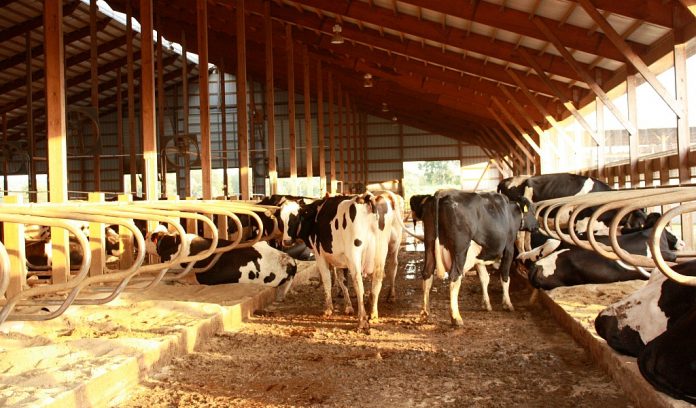
(This article has been updated with quotes and information from OSU Extension Field Specialist Dianne Shoemaker and Pennsylvania dairyman and DFA board member Jeff Raney.)
By Susan Crowell / editor@farmanddairy.com
MEDINA, Ohio — Approximately 225 independent milk producers in the Mideast marketing order have until Nov. 30 to find a new home for their milk.
The dairymen received letters from Dairy Farmers of America’s Dairy Marketing Services, dated May 15, informing them that the cooperative will no longer market the independent producers’ milk. The farmers will receive a six-month notice of termination.
The farmers will have the option of joining DFA or finding another market by Nov. 30, 2017.
This action will affect approximately 92 farms in Ohio; 85 farms in Indiana; 35 in Pennsylvania; six in New York; four in West Virginia; and one in Kentucky. These farms contribute roughly 10 percent of the milk marketed by DMS in Federal Order 33.
It does not affect any organic milk producers who market through DMS.
The announcement comes on the heels of a similar action in the Northeast in March that affected 900 independent milk shippers.
Can’t assess balancing costs
Dairy Marketing Services said growth in the region’s milk supply and declining consumer demand for fluid milk products has triggered a supply-demand imbalance, particularly in the eastern United States.
According to the USDA’s Agricultural Marketing Service, the total milk marketed in the Mideast marketing order (Federal Order 33) has increased nearly 27 percent in the past seven years, from 1.45 billion pounds in April 2010 to 1.84 billion pounds in April 2017. Last year, surplus milk in the region was forced to be dumped, and it looks like additional milk will continue to be dumped this year.
In the Mideast area, Dairy Marketing Services manages and markets milk for some independent producers. However due to federal order blend price payment rules, the balancing costs to move excess milk can only be charged to co-op members. For example, since July 2014, DFA members have been assessed a marketing adjustment charge that is recalculated every month. It has been as high as 95 cents per hundredweight in the Mideast region.
“As a result,” the letter states, “we are unable to continue marketing your milk under the current DMS arrangement.” It was signed by Bill Cummings, chief operating officer of the DFA Mideast region.
Dairy plants and processors typically have a contract with DMS that allows them to get additional milk from DMS when their own producers’ milk isn’t sufficient to keep the plant running. Because of seasonal variations on both the milk supply side and the processors’ demand side, the plants don’t need the same amount of milk all the time. DMS juggles the milk supply distribution to figure out what to do with the balance of milk.
“It’s a challenging job and it’s good that someone is doing it,” said Dianne Shoemaker, Ohio State University Extension field specialist in dairy production economics.
DFA will take members
There is no currently written contractual agreement between the co-op and independent dairy farms.
If the producers join DFA, the co-op said it would waive a capital retain payment (equity investment of 10 cents per hundredweight of milk shipped) for the first year of membership. Co-op members get that investment back, based on a predetermined schedule, should they leave for another market, retire, or leave the dairy industry.
DFA will also allow these independent farms to terminate their co-op membership at any time during that first year, with 30 days’ written notice.
“We understand that there are limited options in the marketplace,” said Heather J. McCann, communications manager with DFA’s Medina, Ohio, office. “We’re not looking for anyone to lose their market.”
Where to go?
There may or may not be other marketing options for individual dairy farms, according to Shoemaker.
“There are still a large number of independent milk buyers in Federal Order 33. The question is, do they need more farmers,” she said. “Those [farms] with the highest quality milk have the best chance.”
Milk buyers include milk and other dairy product processors, as well as the region’s cheese plants. But if a plant is accepting new farms depends on its needs and other variables: the farm’s location and whether or not there is an established milk pick-up route in that area to the processing plant; the amount of milk the farm is shipping; and the breed of dairy cow milked, for example.
Shoemaker cautions farmers to consider all cost factors before making a decision. Ask the milk hauler, the co-op or prospective processor milk buyer about transportation costs — in addition to the regular hauling charge, is there a stop charge (a set amount charged just to stop at the farm); an additional charge per hundredweight; a fuel surcharge; a destination charge?
If choosing to join DFA, dairymen need to consider equity requirements in Year 2, and also participation in the Cooperatives Working Together, or CWT, program, she added. CWT includes an assessment of 4 cents per hundredweight, which funds an export assistance program to expand markets for U.S. dairy products.
Best solution?
Crawford County, Pennsylvania, dairyman Jeff Raney, who serves as chairman of the co-op’s Mideast Area Council, said the co-op has been talking about taking action for several years.
“The whole industry is under stress and this became the best solution available,” he said.
Raney is also on DFA’s executive committee.
McCann said the co-op has been searching for ways to share marketing, transportation and other balancing costs fairly across the marketplace, “but there’s not a good mechanism to do so under the federal order, so we were looking for an alternative that would give producers an opportunity to continue in the marketplace.”
Nationally, DFA markets approximately 22 percent of the nation’s milk supply. There are nine other cooperatives serving various parts of the Mideast federal order.










Ms. Crowell: A little more clarity on the business/politics of this issue, please.